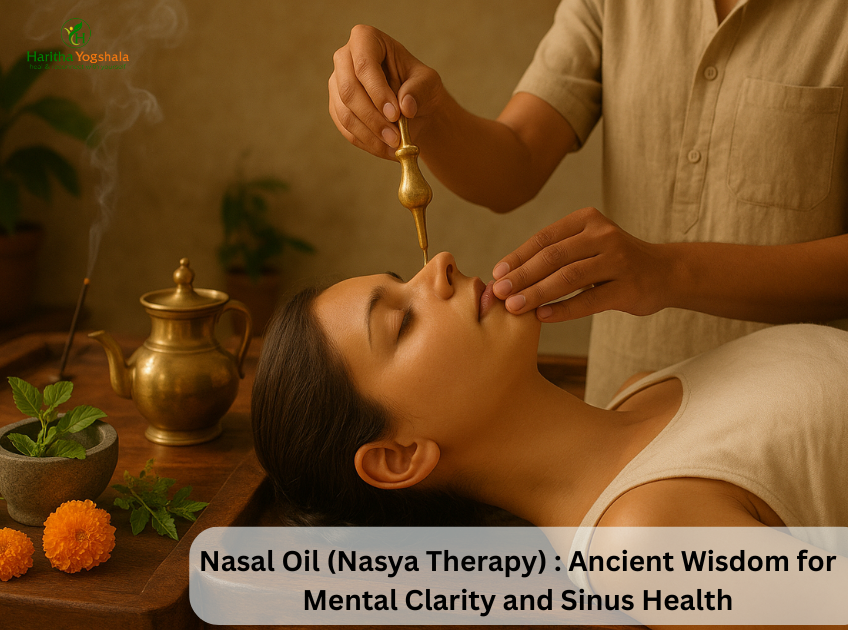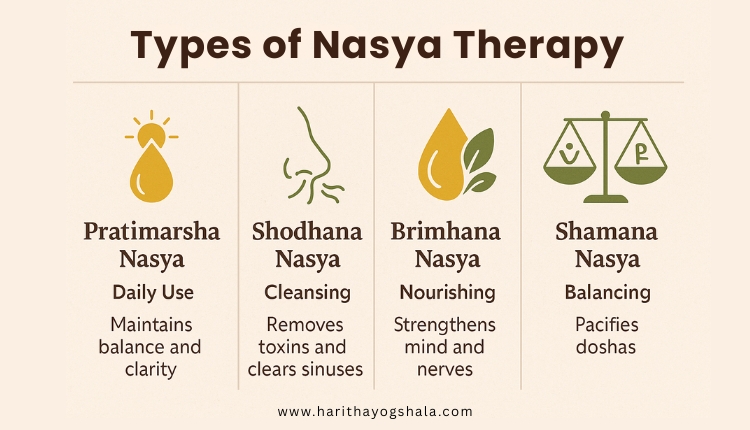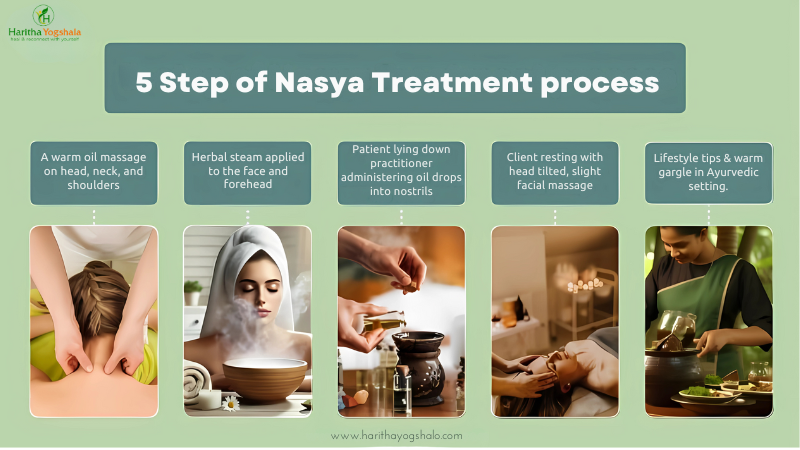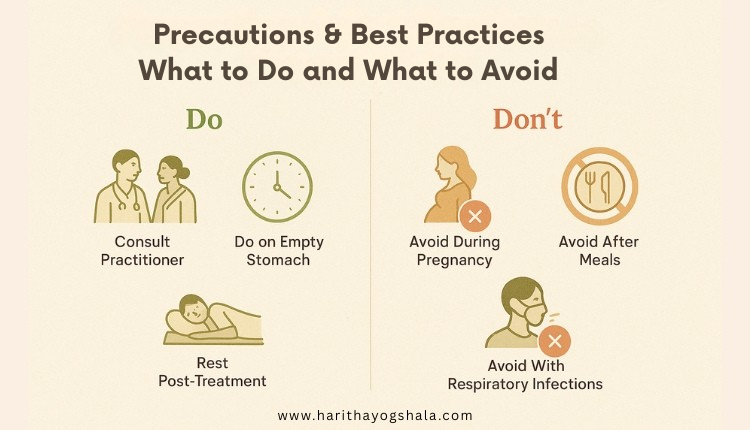
In our fast-paced modern lives, where stress, digital fatigue, and pollution are everyday challenges, people are seeking natural and effective remedies to restore balance. One such time-tested solution comes from Ayurveda, the ancient Indian healing system: Nasya, or nasal oil therapy. This practice may sound unfamiliar to some, but it holds remarkable benefits for mental clarity, respiratory wellness, and overall vitality.
In this complete guide, we’ll explore what Nasya Therapy is, how it works, its benefits for mental and sinus health, the oils commonly used, and what science says about it. Let’s dive into this ancient therapy using simple, easy-to-understand language.
Nasya, pronounced “nahs-ya,” is a form of nasal therapy in Ayurveda. It involves applying herbal oils or medicinal substances into the nasal passages. In Ayurveda, the nose is considered the gateway to the brain and consciousness. By using this entry point, Nasya Therapy can nourish the nervous system, clear blockages, and revitalize the mind and senses.
Ayurveda classifies Nasya Therapy as one of the five main detox treatments, known as Panchakarma. These are specialized therapies used to cleanse and rejuvenate the body deeply. Nasya is particularly helpful for conditions affecting the head, neck, throat, and brain.
Nasya Therapy is not a new-age invention. It has been practiced for thousands of years and is described in classical Ayurvedic texts like the Charaka Samhita and Sushruta Samhita. These ancient books highlight the powerful effects of Nasya on the mind, mood, and respiratory system.

There are several types of Nasya, depending on the purpose:
Pratimarsha Nasya: A gentle, daily practice using 2–4 drops of oil.
Shodhana Nasya: Deep cleansing is used to detoxify excess mucus or toxins.
Brimhana Nasya: Nourishing therapy for strengthening the brain and nervous system.
Shamana Nasya: Used for calming imbalances and managing specific diseases
In Ayurveda, health is about balance. There are three main energies or doshas—Vata, Pitta, and Kapha—that govern our physical and mental functions. Nasya is believed to:
Clear excess Kapha (linked to mucus and congestion)
Soothe disturbed Vata (associated with anxiety, dryness, and insomnia)
Balance Pitta (linked to inflammation and irritability)
When the sinuses and nasal passages are clear and lubricated, prana (life force energy) flows better to the brain. This leads to clearer thinking, better memory, and emotional calmness.

Let’s break down the specific advantages of incorporating Nasya into your daily or weekly routine:
Have you ever felt mentally foggy or scattered? Nasya is said to nourish the brain by improving oxygen flow and removing subtle toxins that cloud mental function. Regular use can lead to:
Reduced mental fatigue
Improved creativity and alertness
Better sleep quality
Many people suffer from sinusitis, allergies, or chronic nasal congestion. Nasya can help by:
Reducing inflammation in nasal tissues
Easing allergy symptoms
Preventing sinus infections
The oils also moisturize dry nasal tissues, which is especially helpful during cold, dry weather or in air-conditioned environments.
Tension headaches and migraines often originate from blocked sinuses or nervous tension. Nasya can relieve pressure and calm the nerves. Ayurvedic oils with calming herbs like Brahmi or Ashwagandha can further relax the mind.
Your nose is connected to your brain’s emotional centers, especially the limbic system. Nasya helps regulate hormones and neurotransmitters that influence mood, reducing anxiety, irritability, and depression.
For singers, public speakers, or anyone who uses their voice professionally, Nasya can lubricate the throat and nasal cavity, leading to clearer, stronger vocal projection.

The effectiveness of Nasya depends heavily on the type of oil used. Each oil has specific properties for targeting different health concerns. Commonly used oils include:
A classical blend used for daily practice. It includes herbs like cinnamon, cardamom, and sandalwood, ideal for clearing sinuses and boosting brain function.
Recommended for chronic sinus issues, hair fall, and migraines. It contains potent herbs like Bibhitaki and Eclipta alba.
Infused with Brahmi, a brain-boosting herb, this oil is used to calm the mind and support memory.
Used especially in dry, irritated sinuses. Ghee is soothing, nourishing, and gentle, making it suitable even for sensitive individuals.
If you’re looking for a deeper and more healing experience, it’s best to receive Nasya therapy from a trained Ayurvedic practitioner. Professional sessions go beyond simple at-home use — they are carefully tailored to your unique body and mind, helping to correct specific imbalances more effectively.
Before the treatment begins, the practitioner conducts a detailed health assessment. This involves analyzing your dosha (body constitution), reviewing your health history, identifying any current imbalances, and discussing your physical, emotional, and mental state. Based on this information, a personalized treatment plan is designed, including the type of oil to be used and the number of sessions required.

1. Pre-Treatment Massage (Abhyanga): The session starts with a warm oil massage of the head, face, neck, and shoulders. This step relaxes the muscles, increases circulation, and readies the nasal tissues to receive the medicinal oil.
2. Steam Therapy (Swedana): After massage, mild steam is applied to the face and forehead using herbal steam. This step further opens the nasal passages, softens accumulated mucus, and enhances the absorption of the oil.
3. Oil Administration (Nasya Karma): With the client lying on their back and head slightly tilted, the warmed herbal oil is gently instilled into each nostril using a dropper or specialized Ayurvedic tool. Typically, 6–10 drops are used per nostril, depending on the individual’s needs. The practitioner may massage the cheeks, forehead, and jaw to aid the oil’s distribution.
4. Post-Procedure Relaxation: After oil administration, the client remains lying down for several minutes to allow the oil to reach the deeper nasal tissues and sinuses. Spitting out any residual oil or mucus from the throat is encouraged. A warm gargle or herbal rinse may also be used.
5. Aftercare Instructions: The practitioner will recommend lifestyle or dietary tips to support the therapy, such as avoiding cold exposure, late nights, or heavy meals on the treatment day.
Acute conditions: For issues like sinus congestion, acute allergies, or migraines, treatment may last 5–7 consecutive days.
Chronic or neurological issues: For long-standing conditions like chronic sinusitis, insomnia, or anxiety, a longer course (10–21 days) may be advised.
Preventative wellness: Occasional sessions at the change of seasons or during periods of high stress can boost immunity and mental clarity.
Nasya therapy at an Ayurvedic clinic goes beyond quick relief — it supports deeper healing. When done by a trained practitioner, it can:
Choosing a skilled Ayurvedic professional ensures the process is safe, effective, and truly restorative. With expert care, traditional methods, and high-quality herbal oils, clinical Nasya becomes a powerful way to support your overall health.
These sessions are more detailed and personalized than home remedies, based on your unique body type (dosha), health condition, and current symptoms.
Pre-Treatment Massage (Abhyanga): The face, neck, and shoulders are massaged with warm herbal oils to relax the tissues and improve circulation.
Steam Therapy (Swedana): Gentle steam is applied to the face and head to open up the nasal passages and prepare them for oil absorption.
Oil Administration: The chosen herbal oil is warmed and gently instilled into each nostril while the client lies on their back with the head slightly tilted backward. The practitioner may massage the forehead and cheeks to aid distribution.
Post-Treatment Rest: After the procedure, the client is advised to rest and avoid exposure to cold air or strenuous activity.
For chronic sinus issues or neurological concerns, a series of treatments (e.g., 7–14 days) may be recommended.
Even a few sessions can offer noticeable benefits for seasonal detox or stress relief.
Receiving Nasya under professional supervision ensures safety and maximizes its healing potential, especially when dealing with complex or chronic issues.
While modern research on Nasya is still growing, several studies suggest that intranasal administration can directly affect the brain, mood, and respiratory function:
A study published in the Journal of Ayurveda and Integrative Medicine found that Nasya with Anu Taila reduced symptoms of sinusitis significantly.
Research has shown that essential oils like eucalyptus, peppermint, and Brahmi have neuroprotective and anti-inflammatory effects when inhaled or used nasally.
Aromatherapy studies support the idea that nasal delivery can influence brain chemistry, reduce cortisol (stress hormone), and enhance serotonin (the happiness chemical).
This aligns with the Ayurvedic belief that the nose is a doorway to consciousness and health.

Though Nasya is generally safe, it's not suitable for everyone. You should avoid it if:
You have a cold, fever, or flu
You are pregnant or menstruating
You’ve just eaten or exercised heavily
You have nasal injuries or recent surgery
Always consult an Ayurvedic practitioner before starting a new health practice, especially if you have medical conditions.
When done incorrectly or with unsuitable oils, Nasya might cause:
Nausea or dizziness
Temporary nasal irritation
Throat discomfort if oil drains into the throat
To minimize risks:
Use clean, high-quality oils
Follow instructions carefully
Start with small amounts and increase gradually
Daily (Pratimarsha Nasya): Safe for regular use, especially in dry or polluted environments
Therapeutic (Shodhana Nasya): Done under guidance, often in cleansing seasons like spring or fall
Consistency is key. Even a few drops daily can make a big difference over time.
In a world where our minds are often scattered and our sinuses are constantly under attack, Nasya offers a simple yet profound way to reconnect with balance. Rooted in centuries-old Ayurvedic tradition and increasingly supported by emerging scientific research, nasal oil therapy is far more than a fleeting wellness trend—it represents a holistic approach to physical, mental, and emotional well-being.
By taking just a few minutes each day to care for your nasal passages, you’re doing much more than moisturizing your sinuses. You’re opening a gateway to your brain, improving your oxygen intake, supporting emotional regulation, and reducing the triggers for common ailments like allergies, headaches, and fatigue. Nasya therapy supports a calm mind, a strong voice, and clear thinking—qualities we all seek in our fast-paced lives.
The beauty of Nasya lies in its simplicity. With just a few drops of nourishing oil and a few minutes of mindful self-care, you can tap into the profound healing potential that Ayurveda has celebrated for millennia. Whether you’re looking to clear your sinuses, sharpen your focus, reduce anxiety, or sleep better, Nasya might be the ancient secret that modern wellness has been missing.
Sometimes, the simplest rituals hold the most powerful secrets. With Nasya, the key to deeper clarity, peace, and wellness could be as close as your next breath.
Disclaimer: This article is written by Ayurveda experts for educational purposes only. Do not attempt Nasya therapy without the supervision of a qualified Ayurvedic practitioner. Always consult a healthcare professional before starting any new treatment or wellness practice.